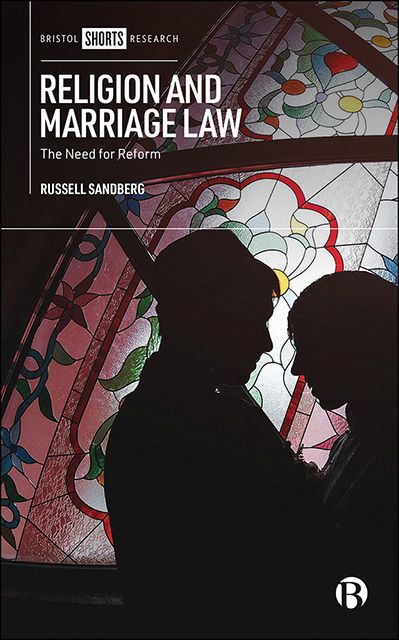Three - Religion and Same-Sex Marriage
Published online by Cambridge University Press: 18 April 2023
Summary
Introduction
For a legal status which has existed for less than 20 years, the law concerning same-sex partnerships and religion has had a turbulent and somewhat confusing history. This chapter examines the story so far. The first part examines how the Civil Partnership Act 2004 originally ignored religion, copying the template of civil marriage. It then charts how this approach fell apart with the introduction of religious civil partnerships. The second part looks at the Marriage (Same Sex Couples) Act 2013 that built upon the existing structure for opposite-sex marriage rather than using the opportunity to craft a modernised, rationalised and codified law on marriage. This has led to an increasingly complex legal framework as shown by the ‘quadruple lock’ that permits but does not oblige religious groups to conduct same-sex marriages.
Civil partnerships
The Civil Partnership Act 2004 was introduced in response to two private Member's bills, which interestingly both sought to introduce a mechanism for both homo-and heterosexual couples. However, unlike these Bills, the Civil Partnership Act 2004 provided recognition and protection only in the case of ‘a relationship between two people of the same sex’ (section 1(1)). Much of the Civil Partnership Act 2004 used ‘civil marriage as a template for the processes, rights and responsibilities that go with civil partnership’. The restrictions on who could enter a civil partnership replicated those for marriage, but for the requirement that the partners had to be of the same sex (sections 3 and 4). Using the template of civil marriage meant that significant confusion existed as to the differences between the two statuses. In Wilkinson v Kitzinger it was stated that the Act bestowed upon civil partners ‘effectively all the rights, responsibilities, benefits and advantages of civil marriage save the name’.
The use of the template of civil marriage also meant that, originally, civil partnerships lived up to their name and were civil and not religious. In the same way as a religious service could not be used during a civil marriage ceremony, originally under section 6 of the Civil Partnership Act 2004 a religious service could not be used ‘while the civil partnership registrar is officiating at the signing’, and the place at which two people could register as civil partners could not be in ‘religious premises’.
- Type
- Chapter
- Information
- Religion and Marriage LawThe Need for Reform, pp. 19 - 28Publisher: Bristol University PressPrint publication year: 2021



